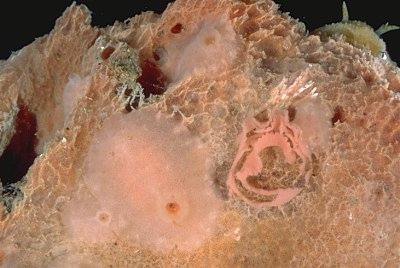
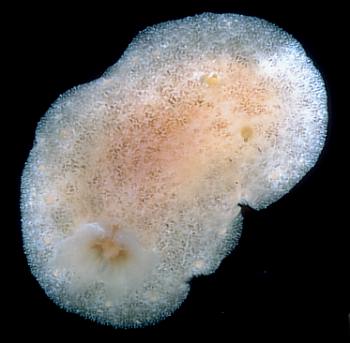
Rostanga australis
Rudman & Avern, 1989
Order: NUDIBRANCHIA
Suborder: DORIDINA
Superfamily: EUDORIDOIDEA
Family: Dorididae
DISTRIBUTION
The species is presently known only from Victoria and South Australia, Australia.
PHOTO
Portsea Pier, Port Phillip Bay, Victoria, Australia. 3 m, 20 specimens (6-32 mm long alive), 6 March 1986. PARATYPES AM C149545.
Upper photo shows many animals and egg ribbon on food sponge, Psammopemma sp.. PHOTOS: Bill Rudman.
See also R. australis - Radula.
See also R. australis - Anatomy
Smaller specimens are translucent white with varying amounts of brown pigmentation forming specks or patches on the dorsal epithelium. These specimens are consequently cryptically camouflaged on their food sponge. Larger pigmented specimens tend to match their food sponge in colour, apparently incorporating the sponge pigmentation in their tissues. One large specimen from South Australia (AM C145182) was pale yellow-brown with a microscopic network of white and dark brown specks each colour forming its own irregular reticulate pattern . Around the mantle, just in from the edge, are spherical pale orange-yellow mantle glands. The caryophyllidia are a pale orange-yellow with a set of white specks at the tip between the protruding spicules. The rhinophore stalk is transparent and the club is translucent brown with white patches at the upper end of each lamella. The terminal knob is brown. The gills are a translucent buff with small dark brown and larger white speckling. A large number of specimens were found in Victoria (AM C149545) on an orange sponge. The background colour was a pale orange-pink with a clear submarginal row of opaque mantle glands. In some specimens there was a scattering of brown patches or specks and some white speckling. The caryophyllidia, as in the South Australian specimen, were pigmented. In some specimens there is a trace of a T pattern on the dorsum with a median line, slightly lighter in colour than the rest of the epithelium, from the gilts to the rhinophores, and a line between the rhinophores. The rhinophore clubs are a translucent orange with a white patch on the upper end of each vertical lamella. In all specimens there is a brown ring around the stalked translucent terminal knob of the rhinophore. The gills are translucent pink with white speckling especially around the upper end, forming a white fringe to the gill cylinder. The body is similar in shape to R. arbutus but in larger specimens the mantle skirt is proportionally wider and the profile slightly more flattened. The caryophyllidia are typical for the genus as are the tripinnate gills forming an upright cylindrical circle. The rhinophores have vertical lamellae and a stalked posterior knob.
Egg masses were found on the sponge food (AM C149545). The pinkish-orange eggs are very small and closely packed in a thin transparent ribbon arranged in a spiral of approximately three coils. The free edge of the ribbon is distinctly crenulate. The size of the eggs and type of egg ribbon are typical of planktotrophic larval development.
Specimens from South Australia and Victoria were found feeding on colonies of a species of the arenaceous poecilosclerid sponge of the genus Psammopemma (Family Desmacididae). In South Australia the sponge had a greyish-purple exterior, (although the interior was a pinkish orange colour) while in Victoria the sponge was pale orange. In both cases the specimens of Rostanga approximated the colour of the sponge colony with which they were associated.
Rostanga australis is unusual for the genus in not being bright red or orange-red. Specimens have ranged in colour from pale yellow-brown to pale orange, matching the colour of the sponge they are feeding on. Juveniles can be a translucent white. The radula is very distinctive with the innermost lateral teeth having a few small inner denticles in juvenile specimens and none in adults. The outermost lateral teeth have four or five short rounded terminal denticles rather than the long rod-like denticles more typical of the genus. The heavily scalloped outer edge to the egg ribbon is also unique.
The species is presently known only from Victoria and South Australia. The name australis refers to this southern distribution.
Reference:
• Rudman, W.B. & Avern, G.J. (1989). The genus Rostanga Bergh, 1879 (Nudibranchia:
Dorididae) in the Indo-West Pacific. Zoological Journal of the Linnean Society 96: 281-338.
Rudman, W.B., 2002 (February 4) Rostanga australis Rudman & Avern, 1989. [In] Sea Slug Forum. Australian Museum, Sydney. Available from http://www.seaslugforum.net/find/rostaust
Related messages
Rostanga australis from Victoria, Australia
July 2, 2003
From: John Chuk
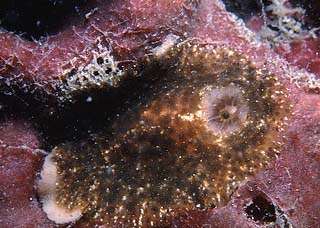
Dear Bill,
This is not a great image but it may be of interest. It is an in situ shot of a rather well camouflaged, dark shaded specimen of Rostanga australis photographed at Flinders Pier, Victoria, Australia on 20 March 2003. The specimen measured 25mm in length and was found on a dark purple sponge, on a pier pylon, at a depth of 3.5m. A portion of a pale egg ribbon is seen protruding from under the anterior border of the specimen.
The dorsum has a somewhat reticulate pattern of very dark brown spots on a brown background. The submarginal mantle glands appear distinctly yellow in colour and there is a vague line of fine yellow spots running in the midline between the rhinophores and gills. Fine pale spots also encircle the gills. I have found several similar specimens in the past year and all were very difficult to spot in natural light.
It would seem that the species is quite variable in shade from pale pink-cream to dark brown. It is a range of shades that rather matches the range of shades seen in the food sponge on which it is usually found.
Best wishes,
John.
jchuk@giant.net.au
Thanks John,
It is an interesting find. I have never seen one quite this mottled brown colour before. It does indeed sem to be very variable in colour
Best wishes
Bill Rudman
Rostanga australis from South Australia
June 25, 2002
From: John Chuk
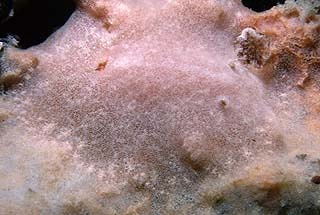
Dear Bill,
Here are images of Rostanga australis and its egg ribbon found at Rapid Bay Jetty, South Australia. The species was common at the site and was always found on a dark blue sponge, often many specimens on the one sponge. The feeding scars were obvious as feeding exposed the pale orange to pink inner tissue of the sponge. Several sponges were found to be hollowed right out with the nudibranchs found on the inner surface. The first image is of such a specimen, which is very well camouflaged against the sponge. The shot was taken on 31 January 2002 at a depth of 5m and the specimen measured 30mm in length. I had to search to find it. The tell tale was the nearby egg ribbon which is shown in the lower left image. This ribbon measured 20mm in diameter.
Many egg ribbons were found and all were very similar in shape and size. They typically consisted of one and a half to two whorls of a flattened ribbon with a ragged crenulated margin. The colour varied from pinkish-orange to pale yellow.
The lower right image is of a specimen photographed on 1 February 2002 in situ on a sponge with many egg ribbons nearby. This specimen measured 16mm in length and was found at a depth of 6m.
Best wishes,
John.
jchuk@giant.net.au
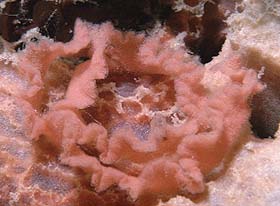
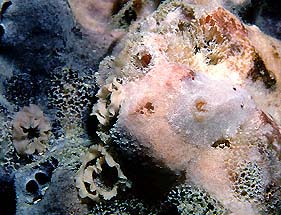
Thanks John,
This and your message of this species from Victoria are very useful additions to our knowledge of the species - effectively doubled our knowledge of the species. It appears that the blue sponge your animals were feeding on is a different growth form of the same animal I have illustrated from Yorke Peninsula where it grew as a series of flask-like structures. I wonder if there is some symbiotic algae or bacteria which is giving the sponge a blue layer in South Australia?
Cheers,
Bill Rudman
Rostanga australis from Victoria, Australia
June 25, 2002
From: John Chuk
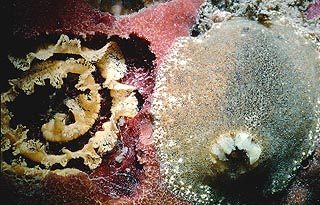
Dear Bill,
Here is an image of Rostanga australis and its egg ribbon photographed at Flinders Jetty, Victoria, Australia on 9 April 2002. The specimen measured 40mm in length and was found on a red-brown sponge at a depth of 2.5m.
The specimen differs from those I photographed in South Australia in that it has black speckling on the notum. This speckling is more concentrated in the central portion between the rhinophores and the gills. The sponge this animal was found on differs from that the species was found on in South Australia.
The egg ribbon measured 30mm in diameter and consisted of a translucent flat ribbon containing yellow eggs. It formed two whorls and had a crenulated margin.
Best wishes,
John.
jchuk@giant.net.au
Chuk, J., 2002 (Jun 25) Rostanga australis from Victoria, Australia. [Message in] Sea Slug Forum. Australian Museum, Sydney. Available from http://www.seaslugforum.net/find/7331Thanks John,
I suspect the sponges may be colour forms of the same thing or closely related. I had the, what I thought, were quite different sponges I had found this species on in South Austarlia and Victoria identified by a sponge expert who considered them to be the same genus and perhaps the same species. As I said in your other message I suspect your flat blue sponge from South Australia is the same as my 'flask-shaped' one. Even if they are different species they are probably quite closely related.
Best wishes,
Bill Rudman
Rostanga australis from South Australia
February 8, 2002
From: Bill Rudman
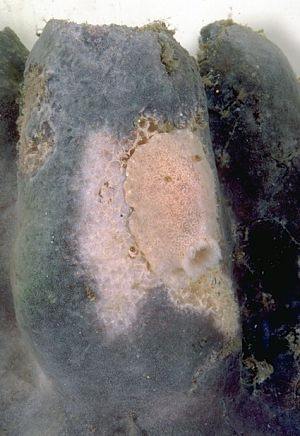
Here is a photo of Rostanga australis from Edithburgh Jetty, Yorke Peninsula, South Australia;
3m, two specimens (5, 30 mm long alive), 20 February 1985, AM C145182. PHOTO: Bill Rudman.
Specimens from South Australia and Victoria were found feeding on colonies of a species of the arenaceous poecilosclerid sponge of the genus Psammopemma (Family Desmacididae). In South Australia the sponge had a greyish-purple exterior, as in this photo, while in Victoria the sponge was pale orange. From where the animal has been feeding we can see that the South Australian sponge is also pinkish orange, apart from the thin external dark grey layer. Then South Australian sponge is quite different in shape, forming large goblet-shaped bodies, while the Victorian sponge forms large lumpy 'shapeless' masses.
Bill Rudman
Rudman, W.B., 2002 (Feb 8) Rostanga australis from South Australia. [Message in] Sea Slug Forum. Australian Museum, Sydney. Available from http://www.seaslugforum.net/find/6178